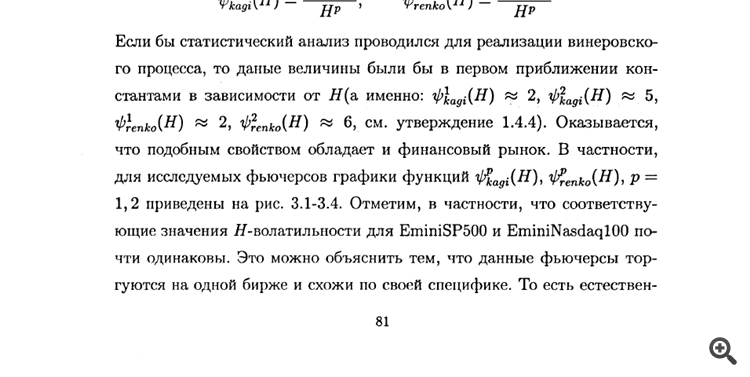从前这里有一个这样的主题 https://www.mql5.com/ru/forum/105771
и
https://www.mql5.com/ru/forum/105771
都是关于H波动性的。还有人对这个感兴趣吗?

- 2007.11.14
- www.mql5.com
该问题与第81页有关。公式稍有不妥,在括号里,Kagi(H)约为2,Kagi2(H)约为5,Renko(H)约为2,Renko2(H)约为6。这些数字有点令人困惑。 Kagi的结构比Renko更敏感,这里的一切都相当于2,然后是一些疑点。
让我提醒一下没有套利市场的情况,我们在构建Zigzag Kagi和Renko H-波动率=2,平坦<2,趋势>2。
我当然赞赏对知识的追求,但我只有两个问题
1)这到底是什么东西?
2)它是用来做什么的?
哦~~~~~~这是什么?
我当然赞赏对知识的追求,但我只有两个问题
1)这到底是什么东西?
2)它是用来做什么的?
好吧,应该理解为,卑微的家庭主妇指的是有学问的丈夫,而不是像你这样的疯子)。
这里也有一份类似的出版物https://www.argolab.net/izuchaem-zigzagi.html
这实际上是同一件事,只是公式略有修改,并引入了过冲的概念。原则是一样的。
所有的人字形都是按阈值使用的,帕斯图霍夫的论文中也是如此。
在Renko zigzag的情况下,它比Kagi更不敏感,H段出现的概率分布 是2的幂,也就是说。
因此,获得了非任意性,即在SB上我们平均有2个区段 在BP上,在相当大的样本中,我们得到相同的数字,即我们有2个以上或2个以下。
我对Kagi人字形分布感兴趣,谁能告诉我,因为没有2。

- www.argolab.net
构建Kagi人字形的例子
https://www.mql5.com/ru/code/1027
而这是一个Renko zigzag,if(High[i]>zzH[last] add + depth ,
} else //direction<0 { if(Low[i]<zzL[last] добавить -depth
//+------------------------------------------------------------------+ //| FastZZ.mq4 | //+------------------------------------------------------------------+ #property copyright "Copyright 2012, Yurich" #property link "https://login.mql5.com/ru/users/Yurich" //--- #property indicator_chart_window #property indicator_buffers 4 #property indicator_color1 Red #property indicator_color2 Red #property indicator_color3 Gold #property indicator_color4 DodgerBlue #property indicator_width3 3 #property indicator_width4 3 //--- input parameters extern int Depth = 300; extern bool AllPoint = true; //--- double zzH[], zzL[]; double depth; int last, direction, pbars; datetime lastbar; double ArrUp[]; double ArrDn[]; //+------------------------------------------------------------------+ int init() { //---- indicators SetIndexBuffer(0,zzH); SetIndexBuffer(1,zzL); SetIndexBuffer(2,ArrUp); SetIndexBuffer(3,ArrDn); SetIndexStyle(0,DRAW_ZIGZAG); SetIndexStyle(1,DRAW_ZIGZAG); SetIndexStyle(2,DRAW_ARROW); SetIndexStyle(3,DRAW_ARROW); SetIndexArrow(2,159); SetIndexArrow(3,159); SetIndexEmptyValue(0,0.0); SetIndexEmptyValue(1,0.0); IndicatorDigits(Digits); //---- depth=Depth*Point; direction=1; last=0; pbars=0; lastbar=0; return(0); } //+------------------------------------------------------------------+ int start() { int limit=Bars-IndicatorCounted()-1; if(lastbar!=Time[0]) { lastbar=Time[0]; last++; } if(MathAbs(Bars-pbars)>1) { last=Bars-1; limit=last;} pbars=Bars; //--- for(int i=limit; i>0; i--) { bool set=false; zzL[i]=0; zzH[i]=0; ArrUp[i]=EMPTY_VALUE; ArrDn[i]=EMPTY_VALUE; //--- if(direction>0) { if(High[i]>zzH[last]+depth) { zzH[last]=0; zzH[i]=High[i]; if(AllPoint) ArrUp[i]=High[i]; if(Low[i]<High[last]-depth) { if(Open[i]<Close[i]) { zzH[last]=High[last]; ArrUp[i]=High[i]; }else direction=-1; zzL[i]=Low[i]; ArrDn[i]=Low[i]; } last=i; set=true; } if(Low[i]<zzH[last]-depth && (!set || Open[i]>Close[i])) { zzL[i]=Low[i]; ArrDn[i]=Low[i]; if(High[i]>zzL[i]+depth && Open[i]<Close[i]) { zzH[i]=High[i]; ArrUp[i]=High[i]; }else direction=-1; last=i; } } else //direction<0 { if(Low[i]<zzL[last]-depth) { zzL[last]=0; zzL[i]=Low[i]; if(AllPoint) ArrDn[i]=Low[i]; if(High[i]>Low[last]+depth) { if(Open[i]>Close[i]) { zzL[last]=Low[last]; ArrDn[i]=Low[i]; }else direction=1; zzH[i]=High[i]; ArrUp[i]=High[i]; } last=i; set=true; } if(High[i]>zzL[last]+depth && (!set || Open[i]<Close[i])) { zzH[i]=High[i]; ArrUp[i]=High[i]; if(Low[i]<zzH[i]-depth && Open[i]>Close[i]) { zzL[i]=Low[i]; ArrDn[i]=Low[i]; }else direction=1; last=i; } } } //---- zzH[0]=0; zzL[0]=0; //---- return(0); } //+------------------------------------------------------------------+

嗬嗬嗬嗬(((那是什么?
这是在最高程度的净化中的 "Woe of Wit"。净化与现实的联系。
